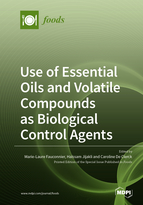Use of Essential Oils and Volatile Compounds as Biological Control Agents
A special issue of Foods (ISSN 2304-8158). This special issue belongs to the section "Food Quality and Safety".
Deadline for manuscript submissions: closed (20 December 2020) | Viewed by 61820
Special Issue Editors
Interests: essential oil; VOCs; oxylipins for applications in agronomy and food science
Special Issues, Collections and Topics in MDPI journals
Interests: biocontrol; essential oils; VOCs; urban agriculture; plant pathology
Special Issues, Collections and Topics in MDPI journals
Special Issue Information
Dear Colleagues,
Essential oils (EOs) and microbial/plant-based volatile organic compounds (VOCs) are being used in an increasing number of sectors such as health, cosmetics, the food industry and, more recently, agronomy. In agronomy, they are employed as bio-herbicides and bio-pesticides due to their their insecticidal, antifungal, and bactericidal effects. Several EO-based bio-pesticides are already registered.
Essential oils and other VOCs are 100% bio-based and present numerous additional advantages. They contain a great number of structurally diverse compounds that frequently act in synergy; they are thus less subject to resistance. As highly volatile compounds are found in EOs and VOCs, they typically cause no residue problems in food products or in soils.
Indeed, the supply of EOs can be really challenging because they are frequently produced in restricted areas of the world with prices and chemical composition fluctuations. Besides, while the high volatility of EOs and VOCs is interesting for some specific applications, it can be a problem when developing a bio-pesticide with long lasting effects. Finally, EOs are frequently phytotoxic, which is perfect for herbicide formulations, but not for other applications. In both cases, the development of a proper formulation is essential.
Owing to the current attraction for natural products, a better understanding of their modes of biological action is of importance for the development of new and optimal applications.
Prof. Marie-Laure Fauconnier
Prof. Mohamed Haïssam Jijakli
Dr. Caroline de Clerck
Guest Editors
Manuscript Submission Information
Manuscripts should be submitted online at www.mdpi.com by registering and logging in to this website. Once you are registered, click here to go to the submission form. Manuscripts can be submitted until the deadline. All submissions that pass pre-check are peer-reviewed. Accepted papers will be published continuously in the journal (as soon as accepted) and will be listed together on the special issue website. Research articles, review articles as well as short communications are invited. For planned papers, a title and short abstract (about 100 words) can be sent to the Editorial Office for announcement on this website.
Submitted manuscripts should not have been published previously, nor be under consideration for publication elsewhere (except conference proceedings papers). All manuscripts are thoroughly refereed through a single-blind peer-review process. A guide for authors and other relevant information for submission of manuscripts is available on the Instructions for Authors page. Foods is an international peer-reviewed open access semimonthly journal published by MDPI.
Please visit the Instructions for Authors page before submitting a manuscript. The Article Processing Charge (APC) for publication in this open access journal is 2900 CHF (Swiss Francs). Submitted papers should be well formatted and use good English. Authors may use MDPI's English editing service prior to publication or during author revisions.
Keywords
- Volatile organic compounds
- VOCs
- Bio-pesticide
- Mode of action
- Formulation







